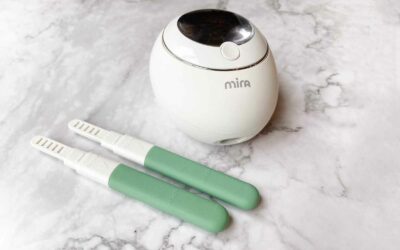What is the Marquette Method?
The Marquette Method is form of natural family planning (NFP, or fertility awareness based method, FABM). The Marquette Method uses Clearblue fertility monitors to measure estrogen and LH levels directly. Daily fertility monitor readings, instead of mucus, are used to identify the fertile window.
I get a lot of clients who have tried other methods of NFP and are thinking of making a switch to Marquette. What I’ve found is that it’s hard to find a source of information that objectively compares the Marquette Method to other methods of NFP. It’s hard to find information that explains why, if a different method of NFP isn’t jiving with your lifestyle, the Marquette Method might be a better option. The information about Marquette online describes it in general terms, aimed at a beginner audience, but many of my clients are by no means beginners! If this describes you, read on. (And if you are new to NFP, I wrote an introduction to the Marquette Method for you, too).
So, what’s the same and what’s different between the Marquette Method and other methods of NFP?
What’s the Same Between Marquette and NFP Methods?
It’s NFP
Let’s start with what’s the same. It’s obvious, but it’s worth noting that Marquette is a method of NFP that, like any other method of NFP, helps you to identify the naturally occurring phases of fertility (and infertility) in your cycle. All methods of NFP are designed to work with human reproduction and the female reproductive system. Your body and your reproductive system will function just as it always has, regardless of which method of NFP you practice. Learning and practicing a new method of NFP means changing which signs of fertility you’ll be tracking, but if you’ve always had long cycles, short cycles, or irregular cycles you’re still going to experience the same type of cycles you always have.
The good news, though, is that Marquette tracks a different combination of reproductive hormones than the other NFP methods do, and it tracks hormone levels directly rather than symptomatically (more on that later), so while the underlying biology is the same, these differences might make your experience with the Marquette Method different from the other methods you’ve tried before.
Just like other methods of NFP, Marquette Method users collect data, record this data on their chart, and use this as the basis for identifying the fertile window. Marquette can be used, like other forms of NFP, to avoid or achieve pregnancy. Just like any other form of NFP, to be effective at avoiding pregnancy, Marquette Method users need to abstain from intercourse throughout the entire fertile window, as defined by the Marquette Method instructions and algorithm. Marquette is NFP, and with NFP no drugs, medical procedures, or barriers interfere with how your reproductive system was designed to function.
Marquette is a relatively easy form of natural family planning to practice, but we’re still dealing with human fertility in all its variability among women (and for the same woman, from cycle to cycle). All of Marquette’s effectiveness research is with couples who were trained and followed by Marquette Method instructors. So, if you’re aiming for the perfect use effectiveness rates, getting formally trained in the method by a Marquette Method instructor is necessary!
It’s Approved by the Catholic Church
The Marquette Method was developed by researchers at the Marquette Institute for Natural Family Planning at Marquette University, a Catholic Jesuit university. If you’re Catholic and practicing natural family planning because it aligns with your moral beliefs, you’ll be pleased to know that Marquette Method instructors are all trained in courses that meet the standards of the United States Conference of Catholic Bishops (USCCB). The Marquette Method is recognized by the USCCB as a form of family planning that is compatible with Church teachings. Of course, you don’t have to be Catholic to practice the Marquette Method. I believe that knowledge about human fertility, and a barrier-free, hormone-free method of family planning is the right of every woman!
What are the Differences Between Marquette and Other NFP Methods
Marquette Measures Hormones Objectively, through Urine Tests
Enough of the similarities, what makes Marquette different? The first major difference is how fertility is observed and measured. Marquette tracks the hormone levels directly (through urine tests), rather than tracking the symptoms of hormone fluctuations (cervical mucus and basal body temperature) throughout the cycle.
A woman practicing the Marquette Method of NFP measures her hormone levels using a Clearblue fertility monitor. This monitor requires the woman to test her first morning urine each morning until the peak of her fertility for that cycle has been identified. The monitor returns one of three possible fertility levels—low, high, or peak—which correspond to specific hormone shifts in a woman’s cycle. This data becomes the basis for identifying the beginning and end of the fertile window in each cycle.
So, one major difference between the Marquette Method and other forms of NFP is that it’s based on entirely objective (rather than subjective) observations. It’s all very “black and white.” There are only three possible monitor results—low, high, or peak—and your result is displayed, clear as day, on the monitor itself.
Tracking hormone levels directly, rather than tracking the symptoms of hormonal shifts, has obvious advantages. It’s just more precise. As seasoned users of NFP understand, NFP is centrally concerned with predicting and identifying when a woman ovulates. The more precise we can be about predicting and identifying the day of ovulation, the shorter the observed fertile window can be, which means less days of ultimately unnecessary abstinence.
Marquette Measures a Different Combination of Hormones (Including LH)
If the first major difference between Marquette and other forms of NFP is how fertility is measured, the second major difference between Marquette and other forms of NFP is what it measures. Mucus-based methods of NFP, like the Creighton Model and Billings Ovulation Method, track the estrogen fluctuations through the cycle (through cervical mucus) and symptothermal methods track estrogen (cervical mucus + cervical position) together with the effects of progesterone (basal body temperature).
Marquette uses the Clearblue fertility monitor, which measures estrogen and luteinizing hormone (LH) levels in the woman’s urine. If you’re familiar with another method of NFP, then you’ll be familiar with the role that estrogen plays in the reproductive cycle, but you might not know much about LH.
LH breaks through the wall of the follicle and causes the egg to be released; LH is the hormone responsible for ovulation—you can’t ovulate unless you’ve had an LH surge. This is a very valuable hormone to be able to track—the LH surge identifies the days immediately leading up to ovulation! The tricky thing about LH is that it’s asymptomatic—you can’t observe any symptoms that tell you that your LH surge is happening. LH levels can only be measured using a blood serum or urinary test. Being able to track LH levels in your urine from home (without having to go to a medical lab to do the test) is what makes the Marquette Method such a different—and uniquely effective—form of NFP … even during the transitional phases of a woman’s fertile life, such as the breastfeeding transition and perimenopause.
Tracking a woman’s LH surge is the gold-standard when it comes to accurately predicting ovulation at home. It’s convenient and reliable. Research has clearly shown that the LH surge precedes ovulation, and without it, ovulation does not occur. LH research, and the development of accurate hand-held fertility monitors that track a woman’s estrogen and LH levels throughout her cycle, is the science that underpins Marquette’s revolutionary approach to NFP.
(Truly, we know all the acronyms we had to use in this post are … a little much. So we made this follow-up guide to NFP acronyms & abbreviations just for you.)
To sum up:
Marquette is NFP. But what sets it apart is how it measures fertility (directly through urine tests, rather than symptomatically) what hormones it measures (estrogen and LH, instead of estrogen and progesterone), and how simple it is to track your fertility—because Marquette Method users usually test their first morning urine, you’ll be done with NFP tracking for the day by the time your breakfast is ready.





